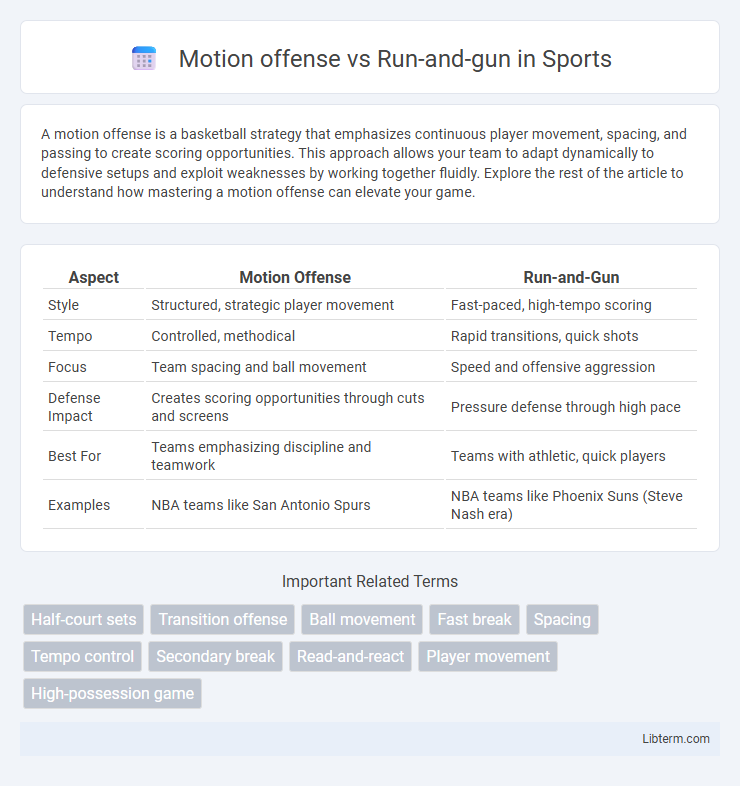A motion offense is a basketball strategy that emphasizes continuous player movement, spacing, and passing to create scoring opportunities. This approach allows your team to adapt dynamically to defensive setups and exploit weaknesses by working together fluidly. Explore the rest of the article to understand how mastering a motion offense can elevate your game.
Table of Comparison
| Aspect | Motion Offense | Run-and-Gun |
|---|---|---|
| Style | Structured, strategic player movement | Fast-paced, high-tempo scoring |
| Tempo | Controlled, methodical | Rapid transitions, quick shots |
| Focus | Team spacing and ball movement | Speed and offensive aggression |
| Defense Impact | Creates scoring opportunities through cuts and screens | Pressure defense through high pace |
| Best For | Teams emphasizing discipline and teamwork | Teams with athletic, quick players |
| Examples | NBA teams like San Antonio Spurs | NBA teams like Phoenix Suns (Steve Nash era) |
Introduction to Motion Offense and Run-and-Gun
Motion offense emphasizes continuous player movement, precise passing, and strategic spacing to create scoring opportunities through teamwork and player reads. Run-and-gun is a fast-paced style prioritizing quick shots and high scoring, relying on speed, athleticism, and aggressive transitions to overwhelm opponents. Both offenses offer distinct tactical approaches, balancing structure with tempo to exploit defensive weaknesses.
Core Principles of Motion Offense
The core principles of Motion Offense emphasize player movement, spacing, and passing to create scoring opportunities through coordinated cuts and screens. Unlike the fast-paced, high-tempo style of Run-and-gun, Motion Offense relies on patience and reading the defense to exploit mismatches and maintain strategic control. Effective execution requires strong basketball IQ, teamwork, and adaptability to fluidly adjust offensive sets based on defensive reactions.
Key Elements of Run-and-Gun Play
Run-and-gun basketball emphasizes a fast-paced tempo, quick transitions, and high scoring, relying heavily on relentless ball movement and spacing to create open shots. Key elements include constant player motion, rapid passing, and aggressive defensive pressure to force turnovers and ignite fast breaks. This style prioritizes stamina and speed, aiming to outscore opponents through an up-tempo attack rather than set plays typical in motion offense.
Historical Evolution of Both Strategies
Motion offense emerged in the mid-20th century, revolutionizing basketball with its emphasis on player movement, spacing, and ball passing to create scoring opportunities. Run-and-gun gained prominence in the 1980s and 1990s, characterized by its fast-paced, high-scoring style prioritizing quick shots and transition play. Both strategies evolved from the desire to exploit defensive weaknesses: motion offense focusing on patience and precision, while run-and-gun capitalized on speed and athleticism.
Player Roles in Motion Offense vs Run-and-Gun
Player roles in motion offense emphasize versatility and constant movement, requiring players to read defenses, set screens, and create scoring opportunities through teamwork and spacing. In contrast, run-and-gun offense prioritizes quick transitions and high-paced scoring, with players focusing on speed, shooting, and fast breaks to exploit defensive gaps. Motion offense demands strategic decision-making and adaptability, while run-and-gun relies heavily on athleticism and rapid execution.
Offensive Spacing and Ball Movement
Motion offense emphasizes precise offensive spacing with continuous player movement and cutting to create open passing lanes, enhancing effective ball movement and scoring opportunities. Run-and-gun prioritizes rapid ball advancement and quick shot attempts, often sacrificing structured spacing for fast-paced transitions and frequent shooting. Effective ball movement in motion offense relies on coordinated passing and off-ball screens, whereas run-and-gun depends on speed and urgency to exploit defensive gaps before they set.
Scoring Opportunities and Pace Comparison
Motion offense creates scoring opportunities through continuous player movement and precise passing, enhancing shot selection and exploiting defensive weaknesses. Run-and-gun prioritizes a high pace with quick shots, generating scoring chances by forcing fast transitions and capitalizing on opponent turnovers. While motion offense emphasizes strategic ball control and spacing, run-and-gun relies on tempo and volume of attempts to maximize points.
Defensive Challenges Against Each Offense
Defensive challenges against Motion offense include navigating constant player movement and screens, which require disciplined communication and switching to disrupt ball handlers and cutters. Run-and-gun defenses struggle with the high tempo and quick shot attempts, demanding stamina and rapid transitions to prevent easy fast-break points. Both offenses test defensive adaptability but differ in pace and spatial coverage demands.
Famous Teams and Coaches for Each System
The Los Angeles Lakers under coach Phil Jackson exemplified the motion offense, leveraging constant player movement and ball rotation to create open shots, while the Detroit Pistons with coach Chuck Daly also utilized this system effectively during their 1989-1990 championship runs. The run-and-gun style is famously associated with the Phoenix Suns under coach Mike D'Antoni, who emphasized a fast-paced, high-scoring approach that led to multiple playoff appearances in the mid-2000s. The Golden State Warriors, coached by Steve Kerr, combined run-and-gun elements with motion offense principles to dominate the NBA with their rapid ball movement and prolific three-point shooting during their championship runs in the 2010s.
Choosing the Right Offense for Your Team
Motion offense emphasizes player movement, spacing, and ball passing to create high-percentage shots, making it ideal for teams with versatile players and strong court vision. Run-and-gun prioritizes fast-paced scoring and quick transitions, benefiting squads with athletic, high-stamina athletes capable of sustained pressure. Choosing the right offense depends on team strengths: motion offense suits disciplined, strategic units, while run-and-gun fits explosive, endurance-driven lineups.
Motion offense Infographic

 libterm.com
libterm.com